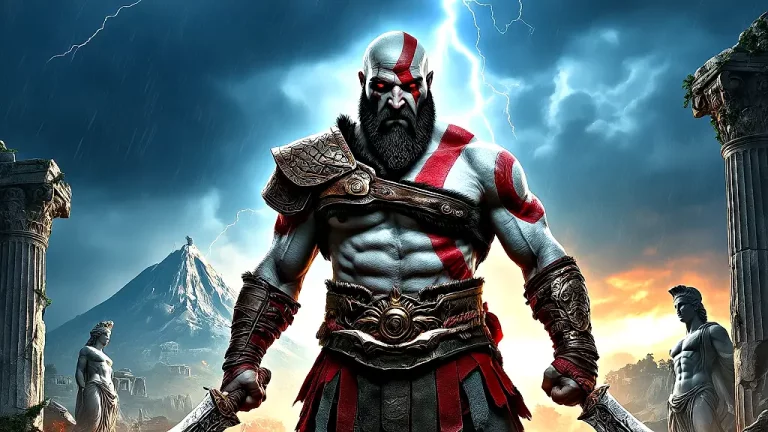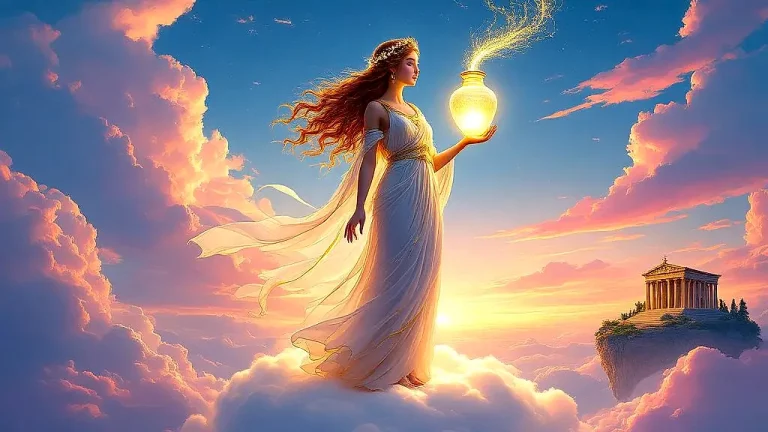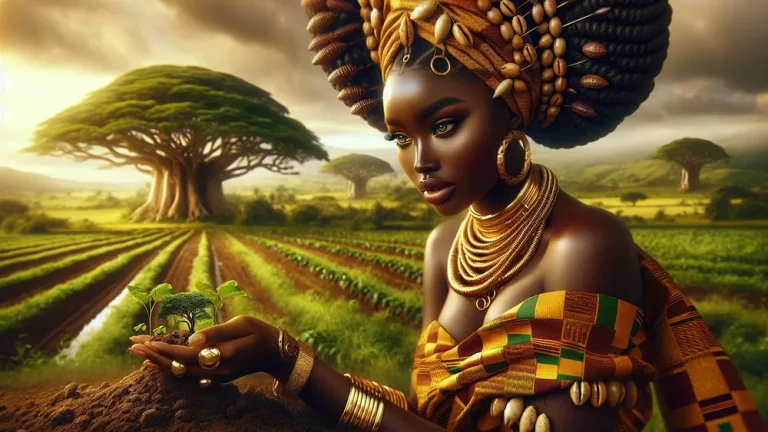Ndomadyiri: The Fire God And Healer In Bambara Mythology
For a long time, people have seen fire as one of the most strong and contradictory forces in myths. It can destroy, yet it also helps things start over, change, and recover. In Bambara spiritual beliefs, one of the most important gods linked to fire is Ndomadyiri. Although not well-known by many, he matters a lot.
Key Points:
- Ndomadyiri is the Bambara fire god, linked to both destruction and healing.
- Fire in his mythology cleanses sickness and removes spiritual impurities.
- Priests perform rituals using sacred flames, herbs, and chants to connect with him.
- Myths tell that he saved villages from curses and fought a giant serpent of darkness.
- People honor him with offerings like burning herbs, oil lamps, and animal sacrifices.
- Fire festivals and ceremonies play a key role in Bambara spiritual traditions.
- He is similar to other African fire gods but is unique in his role as both purifier and healer.
He represents not only the wild power of flames but also how fire plays a sacred part in making things clean. The Bambara people, who mostly live in Mali and nearby places in West Africa, have a deep tradition of storytelling. They say that gods and spirits control natural forces.
Ndomadyiri, above all, is at an important point between creating and purifying. Fire, connected to him, both hurts and fixes. His effect reaches beyond stories – it is seen in healing customs, where fire is used to remove things that don’t belong, not just from the body but also from the spirit.
While fire gods exist in many African traditions – including the Yoruba god Shango and the Fon god Hevioso – Ndomadyiri is different. The thing that makes him special is how he is linked to holy flames that are part of rituals meant to make things clean and new again.
This text will go into detail about his beginnings, what makes him who he is, the stories told about him, and the rituals done in his name. From this, one can see that fire does not just bring damage – it is also a power that brings balance and brings things back to how they should be in Bambara belief.
Ndomadyiri: Overview and Key Facts
| Feature | Description |
|---|---|
| Name | Ndomadyiri |
| Role in Bambara Mythology | God linked to fire and healing. |
| Cultural Origin | Part of the beliefs of the Bambara people, mainly in Mali and nearby areas in West Africa. |
| What Fire Means | Fire can destroy, but it also helps with cleansing and making things new again. In fire rituals, people seek both healing and purification. |
| Main Qualities | Protects against evil, helps remove sickness and spiritual problems, gives fire for daily needs (warmth, cooking) and special purposes (rituals). |
| Sacred Things | Flames, burning herbs, fire lamps, and smoke from rituals. |
| Well-Known Stories | – The Village Under a Terrible Curse: A village suffered from disease and drought, and Ndomadyiri helped by using fire to make things pure again. <br> – The Giant Serpent of Darkness: A huge and chaotic snake threatened the land, and Ndomadyiri fought it using his holy flames. |
| Ways People Honor Him | Priests performed fire ceremonies, rituals for healing, and acts meant to cleanse impurities. People gave gifts to him, hoping for protection from sickness and bad luck. |
| Things Given in Rituals | Fire-lit lamps, special herbs, animals as sacrifices, and objects that stand for cleansing. |
| Connection to Other Gods | He is similar to some fire gods in African and world traditions, such as Shango (a Yoruban god connected to lightning and fire) and Agni (a Hindu fire god). |
| Influence Today | Some customs using fire for healing and purification may still be part of certain spiritual ceremonies in local communities today. |
Who is Ndomadyiri? The Fire God and Healer in Bambara Mythology
Among the Bambara gods, Ndomadyiri is both a destroyer and a healer. He represents two sides of fire – on one side, it burns and harms, but on the other, it cleans and heals. People see him as different because he does both. To understand why he matters, one must learn about where he comes from, what makes him powerful, and the stories that explain his abilities.
These parts of his story help explain how fire means more than just destruction – it is also a way to bring balance back.
Where Did Ndomadyiri Come From?
Unlike some gods from other myths, who have a clear origin story, Ndomadyiri does not have just one version of where he came from. Instead, over time, he became part of Bambara beliefs naturally, and people began to think of him as a deity of fire, cleansing, and healing.
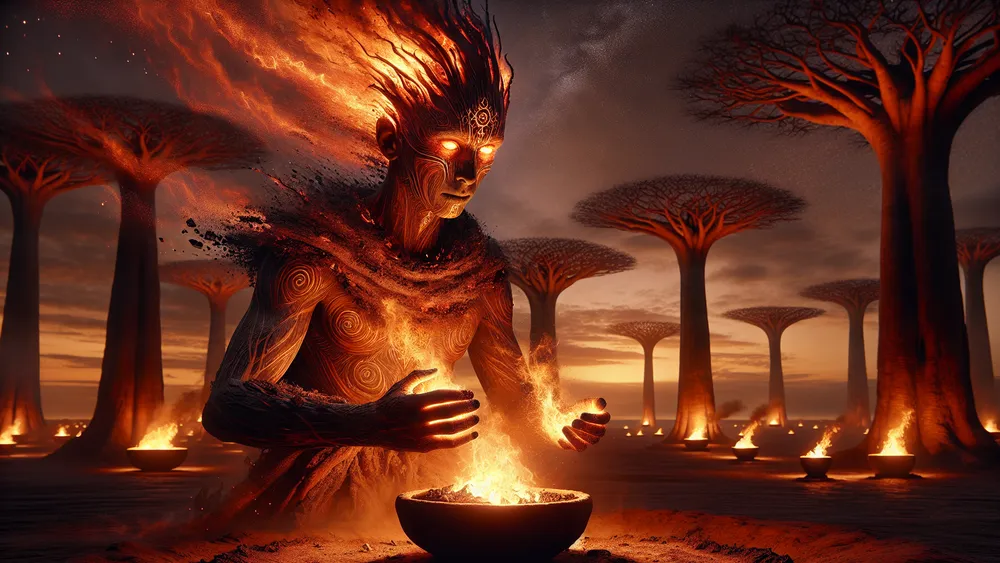
The Bambara people pass their myths down by telling stories, not by writing them. Because of this, different versions of the same story exist, and different people might explain Ndomadyiri’s past in different ways. Some say he was an ancient fire spirit, and only later did people start treating him as a god. Others believe he was never created at all but has always existed anywhere a flame burned.
There are other gods in different cultures with similar ideas tied to them. Agni, a Hindu god, exists both as a cosmic force and as a personal deity. Ndomadyiri is thought of in a similar way.
What matters about him isn’t his birth or beginning, but the idea that he is one with fire itself – which has two sides, bringing destruction but also helping to renew things. His importance likely grew stronger as the Bambara people started using fire in more ways: first for survival, later for sacred rituals meant to heal and purify.
Ndomadyiri became a god of fire, cleansing, and healing in Bambara beliefs over time, with no single origin story, and people see him as a presence tied to fire itself rather than focusing on where he came from.
What Ndomadyiri Looks Like and What He Stands For
Because the Bambara tell their myths out loud instead of writing them down, what Ndomadyiri looks like is not always described the same way. Some people focus less on how he physically appears and more on what he represents. Many say he is not like a person at all, but instead, he is fire itself, with no solid shape that stays the same.
There are stories about him being covered in fire that moves as if alive, making it impossible to see him as anything other than a force connected to flames.
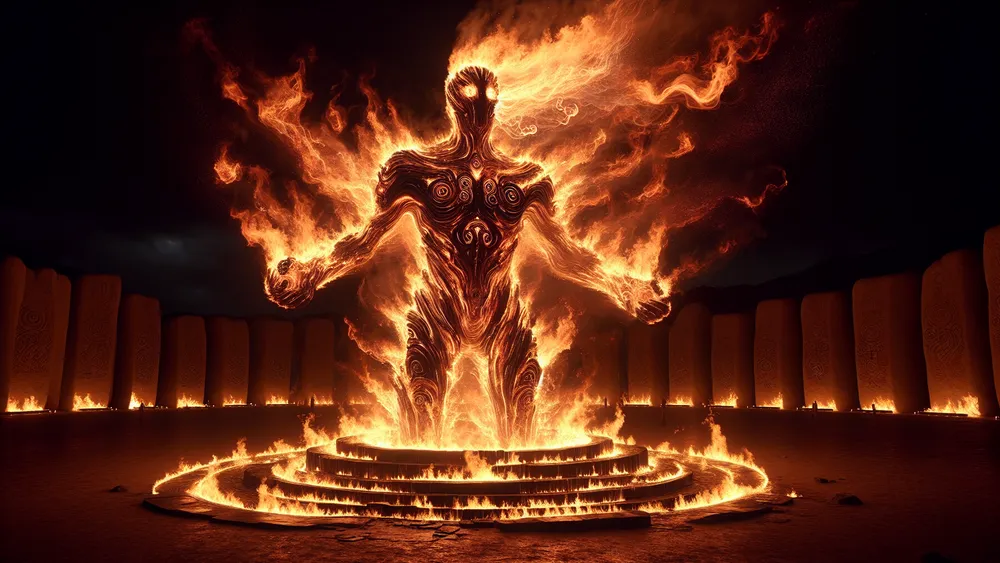
Some describe him as an old spirit whose body is full of burning embers, while others say he is only made of pure fire, a being that can only be seen during rituals or important moments. His most important trait is how fire explains what he does – it both destroys and cleanses.
In some ways, he is like Agni, a Hindu god who acts as a bridge between gods and humans through fire rituals. Ndomadyiri, too, is seen as being wherever flames burn, especially in ceremonies meant to purify. People called on his power to cleanse, and they often burned flames or sacred herbs to bring his energy close.
Here are some of the main ideas connected to Ndomadyiri:
- The Two Sides of Fire – Ndomadyiri means both destruction and starting over. Fire can burn what is bad, but it also opens space for new things to grow.
- Fire as a Way to Heal – His flames remove sickness and take away spiritual problems, an idea seen in Bambara healing customs that use smoke and heat.
- Flames and Smoke in Rituals – Since fire is his element, people believed it was a way to connect to him, often burning herbs to reach him.
- Cleansing and Personal Change – Because he is tied to fire, he is also tied to purification. In rituals, people saw him as part of spiritual cleansing and even rebirth.
- A Barrier Against Evil – Some myths say he keeps dark spirits away, using his fire to force them out and bring back balance.
Myths and Stories of Ndomadyiri
People can better understand Ndomadyiri’s power not by studying written records but by listening to the stories told about him. These stories explain what he did, and from them, one sees that fire was not just something he controlled – it was part of him. Some stories focus on destruction, where he burned what was unclean or dangerous. Others tell of healing, fire being used to remove sickness or protect people from harm.
In every case, fire was a tool that meant purification, protection, and change.
The Story of Ndomadyiri and the Village Under a Terrible Curse
One version of the myth tells of a wealthy Bambara village that suddenly fell to a merciless curse. Without any warning at all, their rivers dried up, their animals died off, and a strange sickness spread among the villagers. People grew weak. Nothing helped. Not one of the healers knew how to stop the illness, and no one who called for rain could bring water back.
The elders feared that the village had upset a powerful spirit without realizing it, so with no other options left, they sent someone to seek out the sacred priests of Ndomadyiri. Days passed. The priests performed rituals to find answers, and at last, they gave their response: only fire would remove the curse.
The problem had been caused by a spirit that once lived near water, but now it spread sickness instead of life. Fire could stop it. But fire needed to be handled correctly – otherwise, it would not cleanse the village but destroy everything instead. The villagers followed the instructions given by the priests. They gathered wood and special herbs used in sacred rituals.
Then, in the middle of the village, the priests began the fire, and though many feared the flames would spread too far, that did not happen. Instead, the fire burned in a way that did not seem normal, forming a circle around the people but not harming them. Smoke rose high, carrying the chants of the priests as they called upon Ndomadyiri’s power.
As the night passed and morning came closer, something changed. The air smelled of burned herbs. The sick people’s bodies became stronger again, and the village started feeling different – as if the fire had truly burned away the curse. Then the sun appeared. At that moment, gray clouds filled the sky, and finally, after a long time without rain, water poured down.
From that day on, the villagers honored Ndomadyiri not just as the god of fire – but also as the god who could heal through flames, a god who did not just destroy but also gave life back when it was needed.
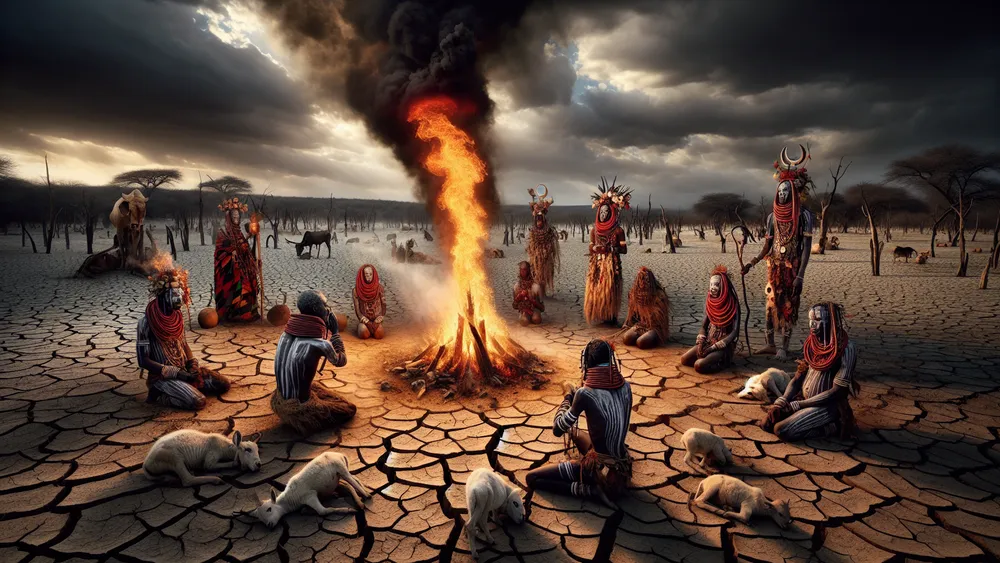
When Ndomadyiri Fought the Giant Serpent of Darkness
Once, in the stories told by the Bambara people, darkness spread over the land in a way no one had ever seen before. Nothing remained bright. The sun did not shine as strong, fires burned weaker, and people felt a strange coldness everywhere. Beneath the Earth, deep below where no one could see, a huge serpent named Kongono started to move.
It was said that this creature was made of darkness itself, that when it breathed, the air became heavy, and that wherever it passed, the warmth of the world was no more. People saw their crops dry up, rivers turn thick and dark, and fires die too quickly. Fear grew. The elders said that the world might never return to the way it was.
With no other choice, the people called upon Ndomadyiri, the only one who had power against the creeping blackness. He answered. And when he appeared, he did not come as a mere figure – he was flame itself, spreading high into the sky as he came forward to stop the serpent’s destruction. The fight that followed was unlike any battle before.
Kongono moved with such strength that entire forests fell beneath its body, but Ndomadyiri’s flames never stood still. They shifted, burning the ground behind each strike. The serpent attacked fast, its body twisting as it tried to crush fire itself, but before it could land its final strike, Ndomadyiri answered with flames so bright the sky turned white. For a long time, no one could tell who would win.
But in the end, fire was stronger. Kongono’s body became too weak to fight back, and as its last strike failed, it fell apart into ashes. The darkness vanished. The sun shone down again. The cold that had entered the land disappeared, and people felt heat return to their homes.
From that day, fire was seen not just as something that changed things but as the strongest weapon against destruction itself.
The Secret Fire Ceremony of Ndomadyiri’s Priests
Inside sacred groves where no outsiders were allowed, priests of Ndomadyiri performed a secret ritual that was passed down only to them. The details of this ritual were not shared with anyone outside their group, and only those who had already dedicated themselves to serve the fire god were able to take part.
However, some parts of the tradition still remain known today, and these suggest that the ritual was always performed at night. The people conducting the ceremony wore special robes – red and black clothes meant only for this event.
In the center stood a fire that could never be allowed to go out, and around it, the priests moved in planned steps while they spoke their chants. They threw certain herbs into the flames, herbs that were believed to cleanse everything around them. Smoke rose high above them, carrying the words they spoke into the air.
When the ceremony reached its most important moment, the priests called upon Ndomadyiri’s presence. Some stories say that, at times, the fire reacted in unnatural ways – it continued to burn without using up the wood beneath it. Events like these were taken as clear signs that the god had appeared. The ceremony had two purposes. First, it was a way to continue showing respect to Ndomadyiri.
Second, it allowed priests to understand what was going to happen in the future. By watching how the fire moved, they could learn if good things were coming or if danger was on the way.
Honoring Ndomadyiri: Rituals and Practices
The Bambara people respected Ndomadyiri through special gifts, important rituals, and guidance from his priests. Their ceremonies were meant to keep him pleased so they could continue receiving his favor, and they believed fire could be used in ways that would cleanse, heal, and keep them safe.
What People Gave to Ndomadyiri as Gifts
To gain Ndomadyiri’s approval, people gave items that had special connections to fire, cleansing, and change. These were not chosen randomly. Each one had an important meaning in their religion and was part of keeping order between destruction and renewal. Some of the most usual gifts included:
- Oil lamps and torches – These stood for a fire that never went out, which the priests believed kept them connected to Ndomadyiri. During ceremonies, they would light them to call upon his presence.
- Medicinal plants and sacred wood – Specific leaves and bark, such as guinea pepper and baobab, were burned because people believed their smoke could cleanse the air, carry their words to Ndomadyiri, and even help heal sick people.
- Animal sacrifices – Some gave goats or chickens as offerings, believing that their ashes represented both purity and the ability of fire to change one thing into another.
- Metal objects – Fire was needed to shape metal, and because of this, iron workers had a special role in their society. These blacksmiths would bring iron tools or decorative items to give thanks for fire’s ability to create.
- Clay pots filled with embers – These showed how fire could be controlled, used for cooking and warmth, yet also had great power, able to destroy or support life, depending on what Ndomadyiri allowed.
Each of these gifts reflected the importance of fire in their beliefs – it could destroy or heal, and people hoped that by giving the right offerings, they could stay in its balance.
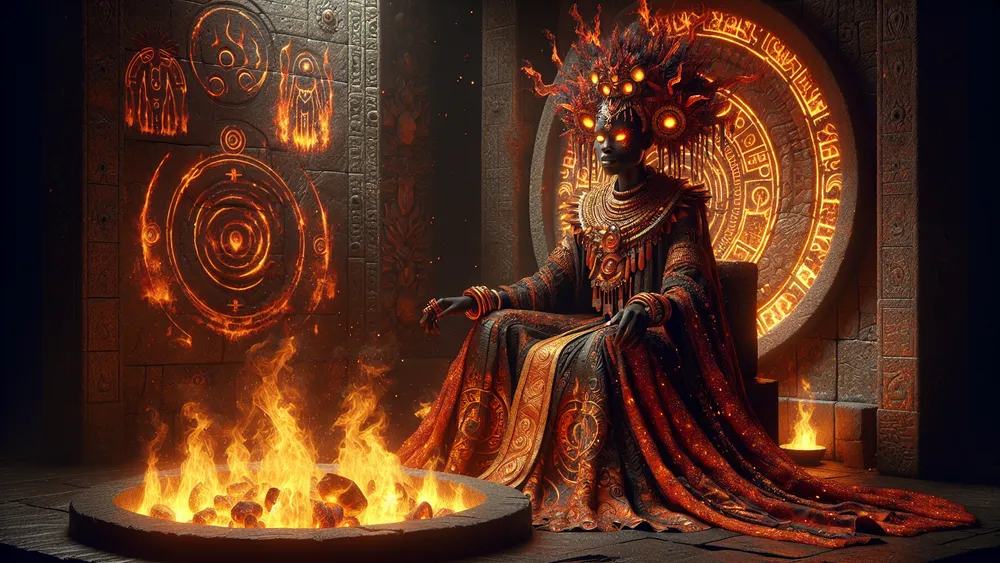
People gave fire-related gifts like lamps, herbs, animals, metal, and embers to Ndomadyiri, believing these offerings kept them in balance between destruction and renewal.
Big Fire Festivals and Ceremonies for Ndomadyiri
In many communities of the Bambara people, large fire ceremonies were held to mark times of change, cleanse what was unclean, and recognize the moment when one thing ended and another began. These events often took place during different times of the year, especially when people believed they needed healing or a fresh start. These ceremonies were major gatherings where entire villages came together.
They stood near very large fires, which they believed linked them to Ndomadyiri. Fire-priests, called kòmò-tigi, led everything. They spoke words of praise for Ndomadyiri and called on him to listen. Smoke filled the air, and people walked through it because they thought this made them cleaner in a spiritual sense. Drums could be heard all night.
People danced around the fire, some lifting torches they later took home, a way to spread Ndomadyiri’s power into their everyday spaces. In some places, people tested their connection to fire – walking barefoot over hot embers or holding burning wood without letting go. Many believed that those who had Ndomadyiri’s favor would not be harmed by fire.
These events helped strengthen the connection between people and their god. They reminded everyone that fire could destroy, clean, and prepare for something new.
Ndomadyiri’s Healers and Their Sacred Knowledge
Among the Bambara, the healers dedicated to Ndomadyiri, called basi-tigi (which means masters of healing), were some of the most trusted people in their communities. They had a deep understanding of how to use both plants and fire in ways people believed could help them.
On one side, they used carefully chosen roots, leaves, and resins to try to heal the body, while on the other, they relied on fire and smoke, which they thought could clear away spiritual problems. Most of the time, healing was done at night instead of during the day. People believed that at night, there was a stronger connection between this world and the gods.
A sick person would stand near thick smoke rising from burning medicinal plants, surrounded by it as the healers spoke sacred words in a steady voice. Some of these rituals involved moving people through a circle of fire, because it was believed that this could burn sickness or bad forces away. Not only did these healers help with sickness, but they also watched the flames carefully for signs.
They believed the way the fire moved or how embers made sound gave them messages from the gods. This knowledge was carefully protected, and only certain apprentices were allowed to learn it through secret ceremonies. Only those who were the most dedicated could be trusted with Ndomadyiri’s sacred teachings.
Ndomadyiri and His Connections to Other Gods
Ndomadyiri was very important in Bambara beliefs, but he was not separate from the others. Other gods had links to him, especially those related to fire, making things, and keeping everything in order in the universe. Fire was not just for burning – it was also part of shaping and changing things, which gave Ndomadyiri a connection to creation itself.
Other Fire Gods in African Mythology
Across Africa, many gods and spirits were connected to fire, playing important roles in people’s legends and beliefs. Some represented destruction, protection, or change, while others were tied to things like war or the power to make new things. The Bambara people had Ndomadyiri, but he was not the only fire god known across African cultures. Many other African cultures had gods connected to fire, which was a powerful force.
People saw these gods as both bringers of chaos and order, using fire for different purposes – cleaning spiritual things, fighting in wars, or making decisions in the name of the gods. Some were tied to metalwork and blacksmithing, which made fire seem even more important for shaping weapons, tools, and sacred objects. Others were called upon in different rituals, such as those for fertility or protection.
Even though different cultures had their own stories and ways of worship, fire was always seen as important.
Below is a table comparing Ndomadyiri to other well-known African fire gods:

| Name | Culture/Region | Attributes and Role |
|---|---|---|
| Ndomadyiri | Bambara (Mali) | Fire god of healing, purification, and transformation; both destructive and renewing. |
| Shango | Yoruba (Nigeria) | God of thunder and fire; tied to lightning, justice from the gods, and warriors. |
| Nyakang | Dinka (South Sudan) | Fire deity tied to kings; believed to give rulers sacred power. |
| Gun | Fon (Benin) | Blacksmith god, master of fire and metalwork, connected to war and making things. |
| Mahuika | San (Southern Africa) | Fire goddess who kept the sacred flame and was part of legends about how people first got fire. |
How Fire Gods Shaped African Creation Stories
Across many African stories of how the world began, fire was one of the basic forces that helped create everything. People believed that gods used fire to shape the land, give life, or separate darkness from light. Some myths describe fire as a special tool of the gods, something they used to make the world the way it is.
According to some beliefs, it was the fire gods who helped form the land itself. This makes sense for gods like Gun from the Fon people, who was thought to use fire to make not only the earth but also everything living on it. Fire did not just destroy. It also created.
There were also myths that said fire split light from darkness, which made it possible for order to exist instead of chaos. This idea appears in stories about the Yoruba god Shango, who brought lightning that could both destroy and light up the world. For the San people, fire was seen as a holy gift that only the gods had at first.
But then, it was later given to humans, so they could use it to survive. Some stories even say that the gods used fire to create humans by breathing sacred flames into lifeless bodies, which gave them life and energy.
Even though the details of these stories were different depending on where they were told, people in many places believed the same thing: fire was not just something that burned. It was a power from the gods that helped make the world and all living things.
How Ndomadyiri Fits Into the Bigger Picture of African Gods
In many African belief systems, gods were organized in a ranked order. There was usually one main god who created everything, like Amma in Dogon tradition or Nyame in Akan beliefs. Below these great gods, there were others who watched over important forces. Ndomadyiri was one of them. His role was different from the creator gods, but still important, because he was in charge of both fire and healing.
Because he both cleanses and destroys, he is similar to fire gods like Shango from the Yoruba people, who represented both the power of lightning and justice. Another similar god was Gun, the blacksmith god of the Fon, who used fire to shape and create things. Unlike gods who were thought of as all-powerful and unreachable, gods like Ndomadyiri were closer to humanity.
Gods like him needed rituals, priests, and offerings to keep things in balance. Fire was more than just heat. It was also a way for people to reach out to the gods to get help or guidance. Because of this, Ndomadyiri played a key role in Bambara spiritual life.
Even though each god had their own role in different cultures, one thing appears again and again: gods were usually tied to the natural world, controlling things like fire, water, or the sky. They were not separate from each other, either. Many gods, including Ndomadyiri, kept a connection with other spirits and forces, all working together to shape the world people lived in.
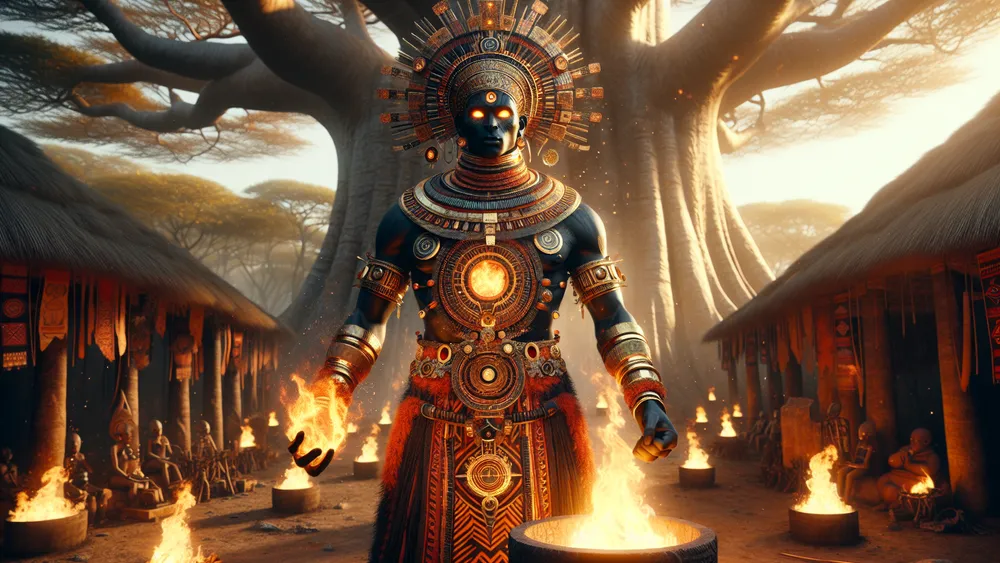
In many African traditions, gods were ranked, with a main creator god above others like Ndomadyiri, who controlled fire and healing, stayed close to people, needed rituals to keep things in balance, and, like many gods, connected with nature and other spirits to shape the world.
Pantheon of All the African Gods
Across Africa, there are many myths, each telling about different gods and spirits. Some gods were creators, like Nyame of the Akan and Amma of the Dogon. Others controlled things like fire, the weather, or war, such as Ndomadyiri, Shango, and Ogun. Some gods are known in many places, while others belong only to specific groups.
The number of gods and spirits across Africa is very large, and their stories are different depending on the people who believe in them. Because of this, people in different regions have their own traditions and religious ideas. If you want to see a full list of all African gods, you can find details about their roles, powers, and importance in myths.
FAQs
1. Was Ndomadyiri worshipped outside the Bambara people?
Ndomadyiri was primarily venerated within Bambara spirituality, but some neighboring Mande-speaking groups may have integrated aspects of his worship into their own traditions.
2. How do myths portray Ndomadyiri’s healing abilities?
How myths portray Ndomadyiri’s healing abilities is through his sacred fire, which burns away illness, purifies the body, and restores balance to those afflicted by spiritual or physical ailments.
3. What kinds of fire rituals were performed in Bambara spirituality?
Fire rituals performed in Bambara spirituality often involved controlled sacred flames used for purification, healing, and communication with divine entities.
4. Are there any modern remnants of Ndomadyiri’s worship?
Modern remnants of Ndomadyiri’s worship can still be found in certain Bambara communities, where fire rituals and healing practices influenced by his mythology continue to be performed.


